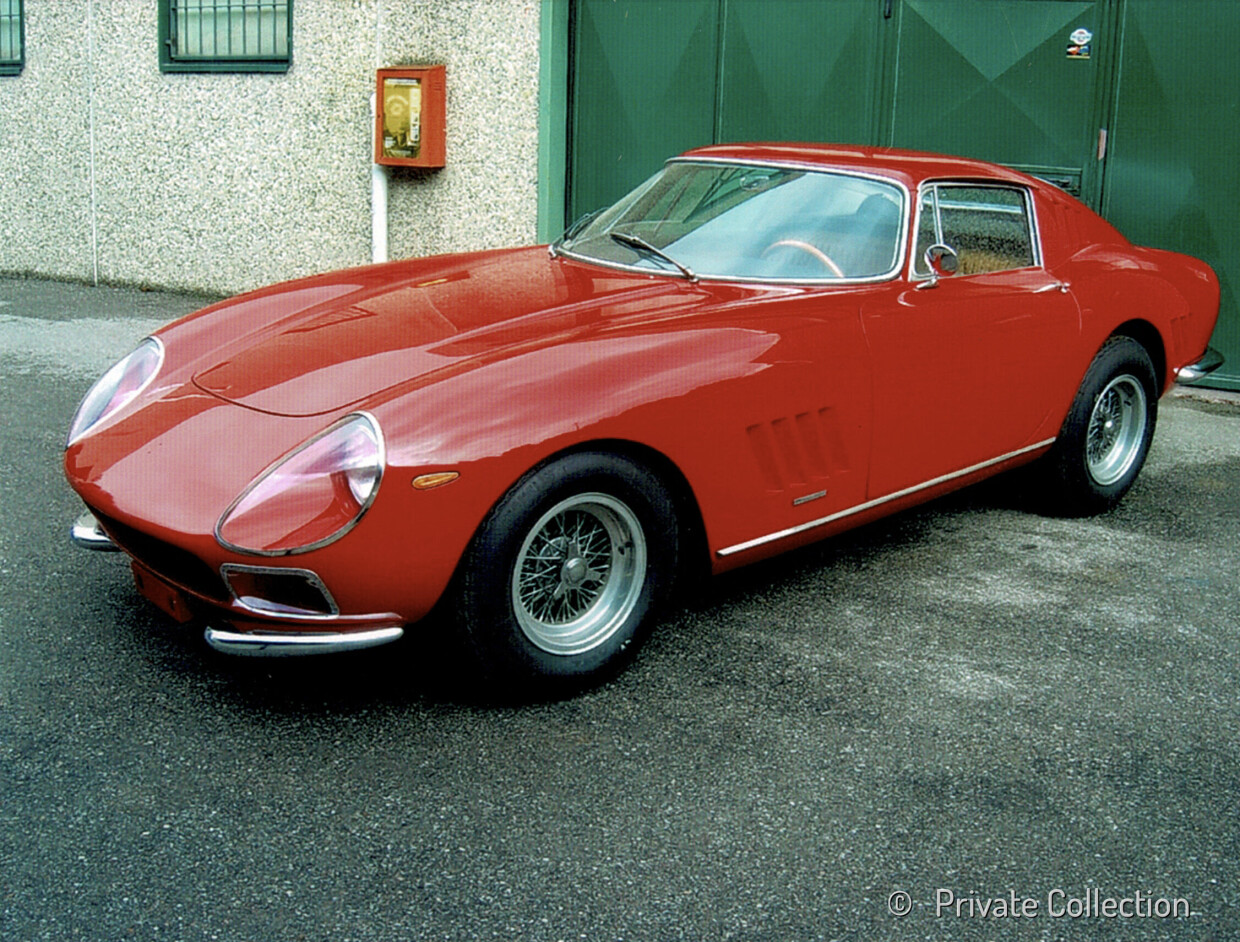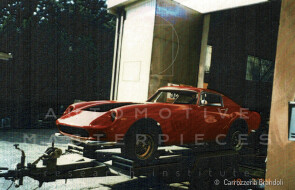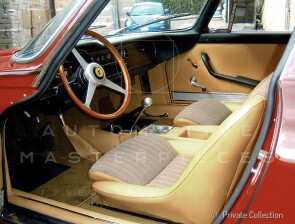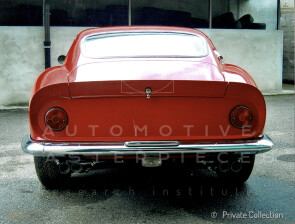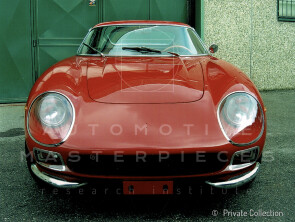
1965 Ferrari 275 GTB/C
ON/OFF
Why am I an Automotive Masterpiece?
L. Limited edition cars
no. 10 manufactured, 3rd built. 03/10 of short nose, first series. 03/22 of total number of GTB/C
The Ferrari 275 GTB is a Berlinetta produced by the Italian manufacturer Ferrari (hence the “B” in the acronym) and was first presented in 1964 at the Paris Motor Show, alongside the spider version known as the Ferrari 275 GTS. The GTB featured taut, slender lines with styling cues inspired by the racing world, such as the distinctive side air vents, truncated tail, and faired headlights. At the request of Luigi Chinetti’s NART (North American Racing Team), ten spider-bodied cars were built between 1966 and 1967, featuring identical bodywork to the GTB/4 Berlinetta—with the obvious exception of the convertible soft top. These were known as the 275 GTB/4 Spider N.A.R.T. A racing version, the 275 GTB/C “Competizione,” was also developed. The 275 GTB was introduced as the successor to the Ferrari 250 series and introduced numerous technical innovations. It was the first Ferrari grand tourer to adopt independent suspension on all four wheels and a 5-speed gearbox. The twin overhead camshaft (DOHC) setup was introduced on the final variants of the model. These important technical advancements were, in part, a response to the newly launched Lamborghini, which had introduced similar features to the grand touring segment with its 350 GTV. The styling was by Pininfarina, who designed a sleek, aerodynamic coupé body mounted on a frame with oval-section tubular side members and diagonal tubular reinforcements. The car featured a long bonnet, accentuating the Maranello-built V12 engine, which benefitted from improved cooling thanks to a larger front grille and four louvers on the front fenders. The headlights were faired, and the cockpit was set far back, while the rear end featured a pronounced spoiler, enhancing the aerodynamic effect of the truncated tail. Three additional louvers on the rear pillars vented hot air from the passenger compartment. The berlinettas were assembled by Carrozzeria Scaglietti in Modena and could be ordered either with a steel body and aluminum opening panels, or as a full aluminum-bodied version. Mechanically, the car retained the V12 alloy engine designed by Gioachino Colombo, with an enlarged bore to achieve a unitary displacement of 275 cc, for a total displacement of approximately 3.3 liters. The engine could be fitted with three twin-choke Weber carburetors (producing 280 hp at 7600 rpm) or six twin-choke Webers (raising output to 300 hp at 7500 rpm). The 275 GTB was both the last Ferrari model with single overhead camshaft (SOHC) and the first with twin overhead camshafts (DOHC) in the GTB/4 version introduced in 1966. The chassis was a spaceframe made of special steel tubes, and the suspension consisted of independent double wishbones at all four corners, with front and rear anti-roll bars. Braking was provided by Dunlop disc brakes on all four wheels, equipped with a brake booster. Perhaps the most significant innovation was the new 5-speed gearbox, entirely built in-house by Ferrari and mounted at the rear in a transaxle configuration, integrated with the differential. The steering system used a worm and roller mechanism. The car came with light alloy wheels by default, although 15-inch Borrani wire wheels were available as an option. All these features made the car agile and fast. However, its performance was somewhat penalized by its weight and by the undersized brake discs, which were prone to fading under hard use.
Separate from the standard production models, Ferrari developed a version specifically intended for competition: the 275 GTB/C, where the “C” stands for “Competizione.” Produced in three distinct series between 1965 and 1966 in extremely limited numbers, this variant was engineered with a strong focus on weight reduction and performance. The chassis retained the tubular spaceframe structure but was further lightened, while the bodywork was crafted entirely in thin-gauge aluminum, hand-shaped by Scaglietti. Additional weight savings were achieved through the use of Plexiglas windows and the elimination of all non-essential components. The Colombo V12 engine was fitted with a dry-sump lubrication system and six Weber carburetors, delivering high performance and increased reliability for endurance racing. The 275 GTB/C distinguished itself in international competition, including the 24 Hours of Le Mans, where it achieved significant results in the GT class—further cementing the model’s sporting pedigree.
The Ferrari 275 GTB Competizione, chassis no. 07421, is one of the 250 so-called “short nose” early cars, produced between 1964 and 1965. “Short nose” is not an official designation, but is commonly used by enthusiasts, collectors, and historians to distinguish the first series of the 275 GTB from later versions. It featured a visibly shorter and more pointed front end, with a more compact hood and a smaller front grille. This configuration caused instability at high speeds due to nose lift. To solve the aerodynamic stability and cooling issues, Ferrari introduced the “long nose” version during 1965, with a more tapered front line and a wider grille, mounted on a slightly modified chassis and front-end structure. Chassis no. 07421 is also—and above all—the third of only 10 “Competizione” examples from the first/short nose series. These cars were characterized by: aluminum bodywork, dry sump lubrication, six carburetors, a 140-liter fuel tank; and externally, by a quick-release fuel cap on the right C-pillar and three air vents on the rear fenders. Further modifications were introduced on the 12 units subsequently prepared based on the second/long nose series. According to factory assembly records, the car was started with the chassis in April, followed by mechanicals in May, and completed with bodywork in early June 1965. It was finished in silver (Argento 106-E-1) with full leather black (Nero 8500) interior; other optional features were agreed with Scaglietti. In early July, it was registered in Rome and titled to Carlo Nervi. He was the fourth son of the celebrated architect Pier Luigi Nervi and the only one who did not follow in his father’s footsteps, becoming instead a renowned oncologist. After almost two years, Carlo Nervi sold the car to Myriam Dreyfus, born in Zurich but resident in Bologna. The car’s history then becomes unclear, possibly moving between Switzerland and France. There are unconfirmed hypotheses that it may have raced for the “Three Bears” Swiss team of owner Peter F. Baumberger. If this were not the case, chassis no. 07421 would represent a truly exceptional instance of a Ferrari “Competizione” without a racing career. In 1974, it appears in the ownership of Patrick Faucompre, a French collector known for his ties to various historic Ferraris. What followed was a tragic chapter: the car was almost destroyed in a garage fire, along with two other notable Ferraris from the Faucompre collection: the 250 GT Lusso sn 4335GT, formerly the personal car of Battista Farina, and the 250 GT Coupé Pininfarina sn 1017GT, which was exhibited at the 1958 Turin Motor Show and later became Gianni Agnelli’s personal car. In 1983, as a wreck, it was sold to Massimo Colombo. The car returned from France to Italy in January 1986. It was not until 1995 that it was finally reconstructed by restorer Marino Brandoli in Cremona. Following a very challenging and costly restoration, the car returned to splendid condition and was shown in 2016 at AutoClassica, Milan.
